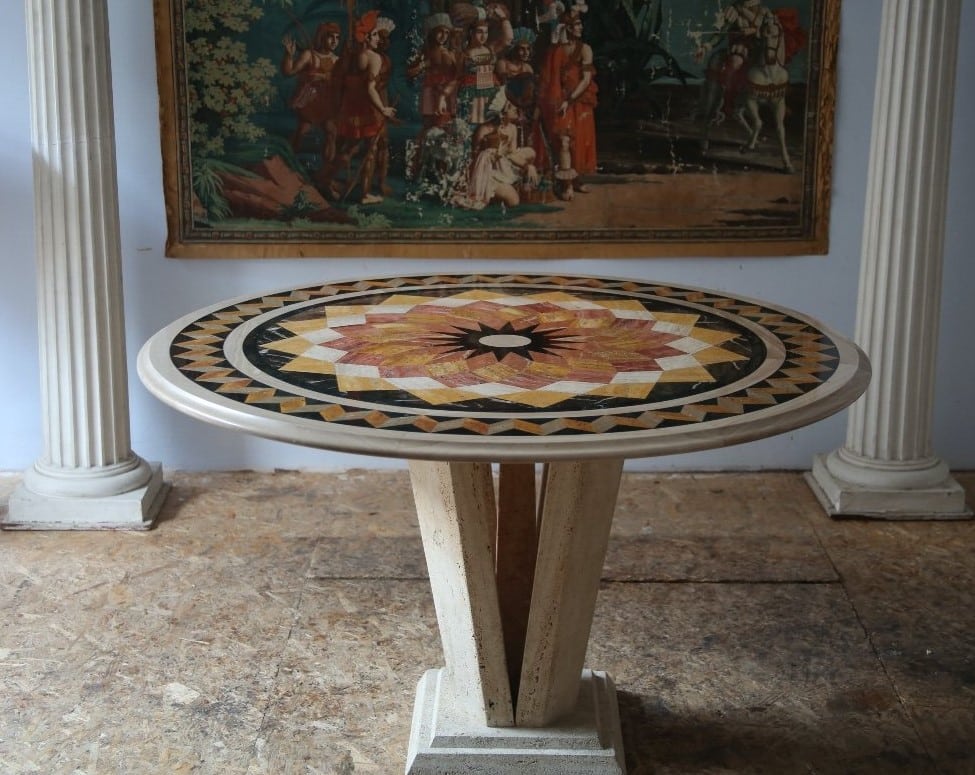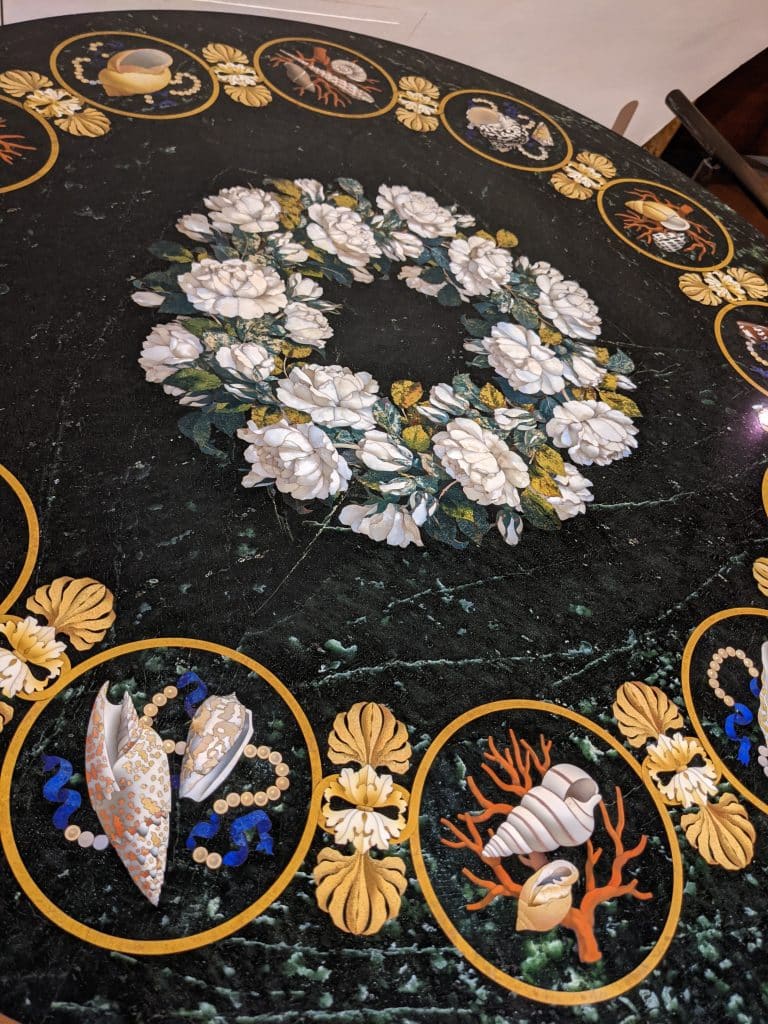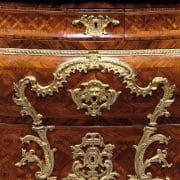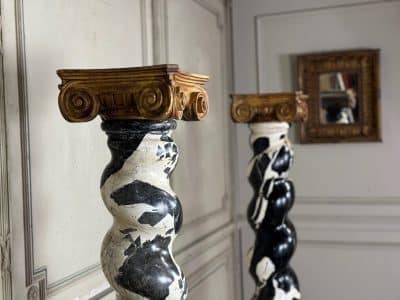Choosing an accent piece in marble simply can not go wrong. Taking marble in, a stone several millions of years old, is like bringing a fraction of eternity to your home. And if you are after a wow effect, you will get it. For this kind of magic, contemporary designers continue integrating marble in their works. Mathieu Lehanneur—designer of the year 2024 for Maison&Objet to illustrate the Tech Eden theme—stars marble in many of his creations, including the Ocean Memories tables.
Marble is contemporary, marble is antique: marble is a classic. Because this stone captivates our eyesight with its veins, irregularities, and the riches of the various shades. Whatever the style, shape, or color, it exudes luxury. Each piece is unique and extremely durable. And the number of furniture pieces and objects with marble is colossal.
This article is a point of entry into the magical world of marble in decorative arts, but based on colors. To celebrate the chromatic possibilities of marble, we will illustrate this introduction to our marble guide with pietra dura mosaic in the form of a selection of polychrome marble tables and table tops (see the last part of our article).

Art Deco Polychrome Marble and Travertine Table. © Galerie Delavigne
Why This Marble Guide
On Proantic, the possibilities of vintage and antique objects and furniture pieces integrating marble are endless. From all sorts of tables and consoles where the marble is core and center to commodes and cabinets where it is a lesser aspect of the overall allure. From dramatic marble columns to smaller decorative objects such as cassolettes, vases, urns–sometimes upcycled as lamps–, obelisks, clocks, boxes, the natural ornaments developed by marble veins and interlocking colors capture our attention and trigger our desire to take it home.

Vase-shaped planter in Salernes breccia marble. © Laurent Chalvignac
However, if you are not a marble connoisseur, you may lack the proper vocabulary to conduct an effective search for marble objects. In this case, you are likely thinking in terms of colors for the marble piece you are looking for. That is why we decided to provide you with a guide connecting the marble shades with the most common marble types used in European antiques. We hope this guide developed over several articles will provide you with keys opening new doors for deeper searches.
A Guide to Our Guide
We did not approach this list from a geological perspective but looked at the marbles through an aesthetic prism. Behind one short word, marble, there is in fact a world of shades and shapes. Carrara marble, the most famous of them, is essentially white and celebrated for its purity. Its milky luster is ideal for sculptures. However, with this guide we are focusing on marble in decorative arts, where marble is used not so much for its uniformity and homogeneity as for its numerous colors and patterns.

18th-century pietra dura table from Naples. Probably with yellow Siena, red Campan, grey Turquin, Carrara, violet brocatelle, verde antique, lapis lazuli, mother-of-pearl. © Galerie Pellat de Villedon
Also, bear in mind that we view it from a perspective centered on European antiques and vintage, which explains why we highlight essentially French, Italian and Belgian provenances. This guide is not exhaustive. We are focusing on the marble types that are either the most famous or common.
Connecting Marble Colors and Marble Types
Over the following months, six more articles on marble will be accessible to develop the color palettes below, giving details for each type of marble listed. Because Proantic started in France and carry a wealth of French items, the articles will also mention the French marble names.
White, Grey and Black Marble Types
Yellow to Red Marble Types
Green Marble Types
Definitions of Marble
The artistic bias we have in this article is not something new when it comes to marble. Yet, because marble is a rock, with our 21st-century mindset, we are tempted to approach it based on its geological definition: marble is a metamorphic rock essentially made of crystallized calcium carbonate (or dolomite). Thanks to heat and pressure, sedimentary rocks (limestone composed of shells and skeletal fragments of marine organisms) accumulated over 330 million years ago eventually turned into marble.
But this scientific definition is far more restrictive than what marble meant most of human history. Since Antiquity, and even during the classical period, marble was viewed from an aesthetic perspective. “Marble” comes from the ancient Greek term mármaros, meaning “shining stone”. It encompassed all hard semi-precious stones that could be polished, including jasper, onyx, lapis lazuli, malachite, alabaster, agate, porphyry, granite (and more) on top of what we know today to be marble.
A Quick Overview of Marble in Decorative Arts
Marble is used since Antiquity for its decorative qualities. Not only as a construction material (like the temples on the Acropolis of Athens built in the 5th century BCE), but also for its ornamental attributes thanks to the randomness of its veins and the range of the colors. Based on Pliny, Rome imported and used polychrome marble from the 2nd century BCE. Moreover, the villas in Pompeii with walls decorated with faux marble paintings perfectly illustrate the fascination for these luxurious stones and the appreciation of their grandiose visual effect when put together.
The technique of opus sectile (a composition of pieces cut in geometric or figurative patterns) was used by Romans to decorate floors and walls. This was different from the tesserae mosaic made only with small square pieces of stone. Some sophisticated examples of opus sectile we still have today are originally from the Basilica of Junius Bassus in Rome (4th century CE).

Opus sectile panel from the Basilica of Junius Bassus. © Musei Capitolini
As Renaissance was rediscovering Antiquity’s canons, the technique of pietra dura (meaning ‘hard stone’; also found under its plural form, pietre dure) marquetry re-emerged in Rome in the 16th century. It was applied to great talent to tables, as attested by the Farnese table.
This technique was brought to its highest form in Florence with the sponsorship of the Medici. The Grand Duke Ferdinando I created the Opificio delle Pietre Dure in 1588. It was the official workshop working exclusively for the Medici court. The Grand Duke was seeing their art as ‘paintings of stone’ known as commesso. Semi-precious stones, i.e. stones different from marble geologically speaking, were largely incorporated for their colors and prestige.

Table with a garland of roses and shells. Design by Giovan Battista Giorgi 1860. © Opificio delle Pietre Dure (picture CC Christelle Colin)
Polychrome Marble Tables & Table Tops
As said previously with the Farnese table example, table tops were early on among the favored applications for marble and stone inlays. The examples we selected below should help you grasp the kind of tables available today on the antique and vintage market. At this point, it should not come as a surprise that many of the works for sale are from Italy, mostly Rome and Florence, but not only.
Two types of table tops stand out. One features an assemblage of marble specimen (according to its antique definition, i.e. including many other hard stones) with geometric shapes, sometimes with a micromosaic motif in the middle emphasizing the antique allure of the piece. The second type features ornamental tableaux filled with flowers (and other naturalistic motifs) arranged in bouquets or garlands and/or coats of arms or military trophies.
Side Tables
Below, this gueridon table on a mahogany foot is from Rome and was created around 1830. It boasts a complex decor. On top of 84 samples of hard stones (separated by black marble), a rim of Vert de Mer marble and Carrara marble, there is a micromosaic scene and antique vitreous paste of the hellenistic period (1st century BCE – 1st century CE). Among the samples are found agate, lapis lazuli, malachite, jasper, portor marble, grand antique, brocatelle, granite, alabaster, cipolino marble, red porphyry from Egypt, green porphyry from Greece. This table is attributed to Francesco Sibilio who was a Roman collector, marble craftsman, and dealer of antiquities active in the first half of the 19th century.

19th-century gueridon table with marble specimen, micromosaic, and ancient glass. Attributed to Francesco Sibilio. © Galerie Nicolas Lenté
Next, the beauty of this gueridon hinges on the Vert de Mer marble exhibiting a rich palette of greens with yellow shades enhanced by the ormolu mounts. The spiral sculpted in the pedestal highlights the marble veins. The hexagonal top is inlaid with a checkerboard composed of white, grey, black, beige and orange marble types surrounded by a belt of red marble resembling a Caunes incarnat.

Empire-style Gueridon side table in Vert de Mer marble. Made in the 20th century. © Galerie Delavigne
Coffee Table
The circular table top below is in the same spirit as the first gueridon table above, yet exhibiting even more marble specimen, a total of 120. It also comes from Rome and was made in the first half of the 19th century. The micromosaic in the middle represents the classic Pliny’s doves from Hadrian’s Villa in Tivoli. The table top is presented here on a coffee table mount.

19th-century Roman circular marble table top with micromosaic. © Olivier d’Ythurbide et Associé
This large coffee table was made in the 1990s with a clear Renaissance inspiration considering the display of emblems and coats of arms. The color palette of the stones is highly reminiscent of the Florentine commesso with strong yellow, red, blue and green shades on a black background.

Contemporary coffee table with a marble-inlay table top. © Frédéric Dulyere
Circular Table Tops
Below is another work of the 20th century in the Florentine mosaic style with large flower bouquets. The white, yellow and blue vividly contrast on the black background.

Polychrome round tabletop with flower bouquets. © C.A.B.A Antiquités
In a different manner, the following 19th-century marble tabletop is only with geometric patterns, star- and rosette-shaped. An alternance of red / light grey and black / dark grey marble rimmed with a Portor-style marble give a restrained elegance to the tabletop. Moreover, the slab back still carries the store label, unequivocally identifying it from Palermo in Sicily.

Polychrome marble round table top from 19th-century Palermo, Sicily. © Antichità Micene
Rectangular Table Tops
This 19th-century Roman tabletop with trophies of a Baroque allure has an incredible ocher tonality. The center medallion is in alabastro fiorito, the rim is in yellow Siena marble. Are also present verde antique, black marble, Spanish brocatelle, lapis lazuli, among other stones.

19th-century commesso rectangular tabletop from Roma. © RÉGIS, Meubles et Objets de goût
This 20th-century tabletop is Baroque inspired as well. It is reminiscent of mosaic floors developed by the architect and sculptor Cosimo Fanzango (1591-1678) in the stupendous Certosa di San Martino in Naples. The complementary of the green and red marble works particularly well thanks to the Carrara white rims.

Marble mosaic rectangular tabletop from Tuscany, early 20th century. © Porta Temporum
With 119 squares inserted in a Carrara marble slab, this 19th-century table top from Florence perfectly illustrates a marble-specimen tabletop with a variety of colors and patterns for a luminous stone-quilt effect.

Marble sample rectangula table top from Florence 19th century. © Borrelli Antichità
You May Like
Marble | Pietra Dura | Tables















